El Banco de Querétaro
The bank was founded on 24 February 1903 when the Secretaria de Hacienda granted a concession to Nicolás del Moral and Guillermo Obregón (representing Agustín Arnaud, Alfonso M. Veraza and Francisco Urquiza) for a bank with a capitalisation of $800,000.
It opened on 30 July 1903Informe of Interventor Tejeda, 20 January 1904 in Memoria de la Instituciones de Crédito, correspondiente al año 1903 in a temporary office at calle 1a de San Antonio núm. 13, whilst its own offices on the corner of calle Don Juan Caballero y Osio and the Jardín Zenea were being finished. At the inauguration Desiderio Reséndiz exchanged $1,650 for the $50 note number 2, $100 note number 1, $500 note number 1 and $1,000 note number 1. Ricardo Honey took $50 number 2 and Agustín Arnaud took $20 number 1. As the $5 and $10 notes had not yet arrived, Nicolás del Moral put down a deposit for $10 number 1 and Guillermo Obregón did the same for $50 number 1El Tiempo, Año XXI, Núm. 5,965, 30 August 1903.
The bank opened a branch in Irapuato in the neighbouring state of Guanajuato on 3 December 1903 with $200,000 in notes prepared for its useibid..
American Bank Note Company print runs
The American Bank Note Company produced the following notes. They engraved special vignettes of a young boy (C265)This has been identified as Guadalupe Obregón, the daughter of Guillermo Obregón, whose portrait also appears on the $5 note of the Banco de Tamaulipas as her father was also an investor in that bank. However, on 16 May 1929, in response to an inquiry from the ABNC, the bank (then in liquidation) said that the vignette was of one of the grandsons of Nicolás del Moral, organizer of the bank. A couple of weeks later, his name was given as Eduardo Jiménez y del Moral, whose profession was that of architect and engineer (ABNC, folder 205, Banco de Querétaro (1907-1933)), Josefa Ortiz de Domínguez (C 264)Doña Josefa Ortiz de Domínguez or La Corregidora (8 September 1768 – 2 March 1829) was married to Miguel Domínguez, corregidor (magistrate) of Querétaro. She was interested in social issues and convinced her husband to organize a number of political meetings in their house. The meetings, attended by educated figures including Miguel Hidalgo y Costilla and Ignacio Allende, became the official location of a revolutionary conspiracy and much of the insurgent planning was carried out there, including gathering weapons and supplies and storing them in various houses.
The beginning of the revolution was planned for 8 December 1810. However, on 13 September, the conspirators were betrayed by a supporter, who informed the Spanish colonial authorities about rebel activities in Querétaro. The colonial authorities, unaware of Domínguez's wife's allegiance, asked the Corregidor to conduct a search in the town in order to apprehend the rebel leaders. He imprisoned his wife in her room to prevent her from exchanging information with her fellow conspirators but she managed to get a warning out through the town mayor. The allowed the leaders of the conspiracy to abandon the town and prompted Miguel Hidalgo to declare war against the Spanish colonial authorities earlier than expected. He gave a speech to his followers known as Grito de Dolores ("Cry of Dolores"), in the early morning of 16 September 1810, an event that signalled the start of the Mexican War of Independence., Juan Antonio de Urrutia y Arana (C 266)Don Juan Antonio de Urrutia y Arana Perez de Inoriza y Chávarri was a rich and powerful nobleman and patron of the arts in 18th-century Querétaro. He built and paid from his own money the Aqueduct to bring water from the springs in "La Cañada" (the Ravine) to the city, including the 74-arch aqueduct, that appears on the back of the notes., and the state's coat of arms (C 881). The vignette of the aqueduct was engraved directly on to the plate.
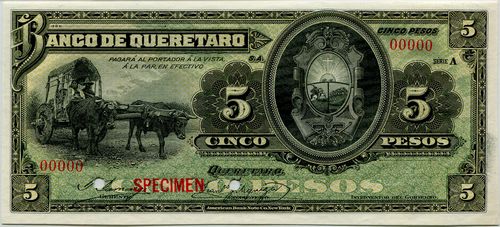
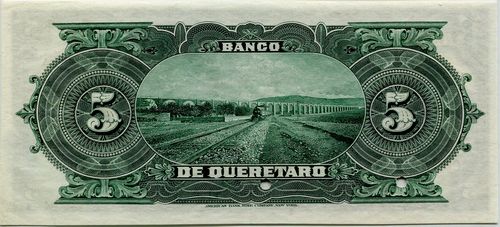
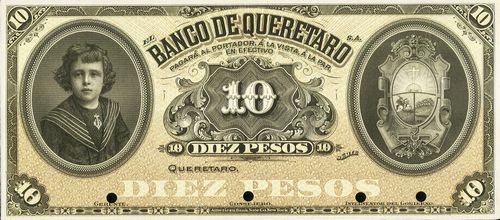
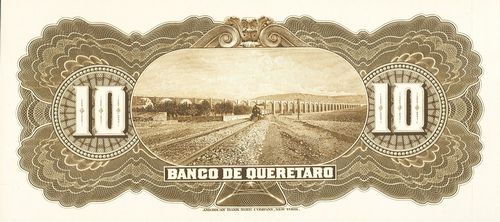
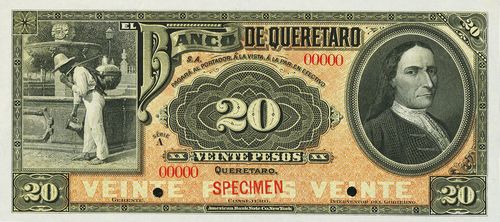
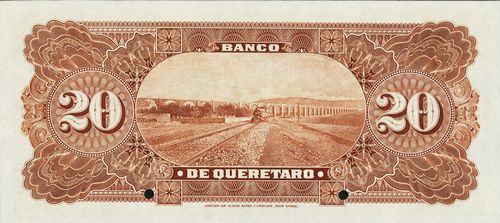

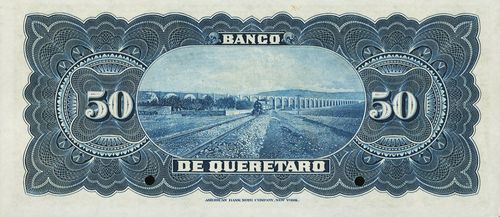
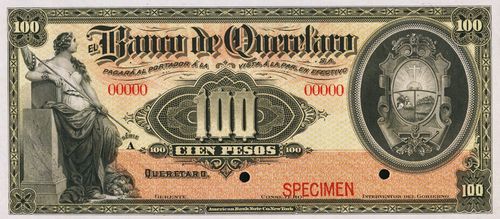
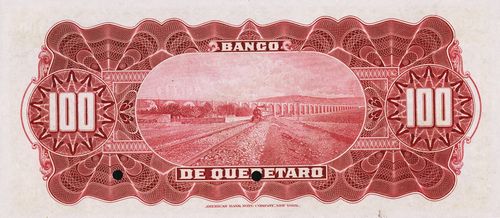
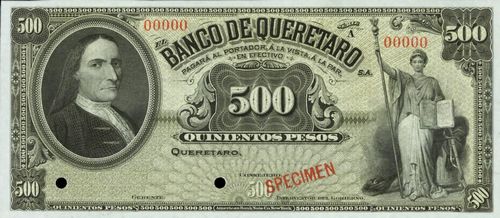
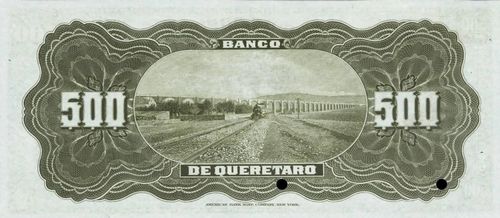
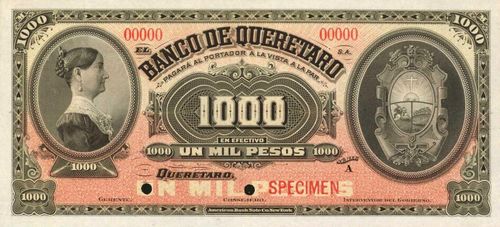
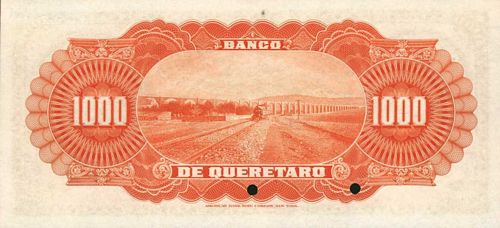
| Date | Value | Number | Series | from | to | Comment |
| March 1903 | $5 | 30,000 | A | 00001 | 30000 | |
| $10 | 20,000 | A | 00001 | 20000 | ||
| $20 | 7,500 | A | 00001 | 7500 | ||
| $50 | 2,000 | A | 00001 | 2000 | ||
| $100 | 2,000 | A | 0001 | 2000 | ||
| $500 | 200 | A | 1 | 200 | ||
| $1000 | 100 | A | 1 | 100 |
The proofs for all the designs were approved, by cable, on 4 JuneAGN, SC244 Antiguos Bancos de Emisión, caja 112, libro 315.
| Date | Value | Number | Series | from | to | Comment |
| April 1904 | $5 | 60,000 | A | 30001 | 90000 | |
| $10 | 40,000 | A | 20001 | 60000 | ||
| $20 | 2,500 | A | 7501 | 10000 | ||
| $50 | 3,000 | A | 2001 | 5000 | ||
| $100 | 1,000 | A | 2001 | 3000 |
On 20 August the ABNC forwarded to the Banco Internacional é Hipotecario de Mexico, in Mexico City, by Wells Fargo Express, two boxes containing these notes. The Banco Internacional é Hipotecario acknowledged receipt on 30 AugustABNC, folder 160, Banco Internacional é Hipotecario (1904-1933).
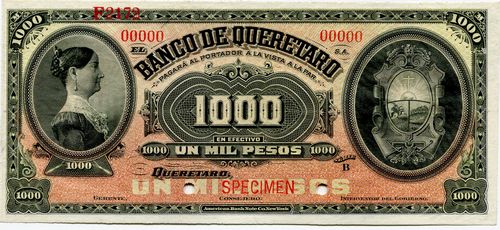
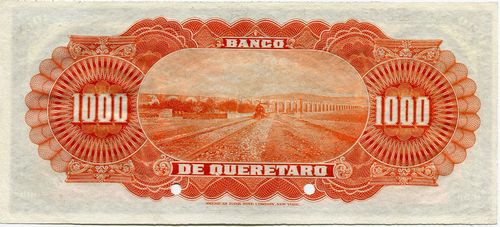
On 11 August 1909 the bank asked for a price and delivery of 1,000 $100, 200 $500 and 100 $1,000 notes and on 7 September the Banco Internacional é Hipotecario de México placed an order for these notesABNC, folder 205, Banco de Querétaro (1907-1933).
| Date | Value | Number | Series | from | to | Comment |
| September 1909 | $100 | 1,000 | B | 3001 | 4000 | |
| $500 | 200 | B | 201 | 400 | ||
| $1000 | 100 | B | 101 | 200 |
The notes were forwarded by Wells Fargo Express to the Banco Internacional é Hipotecario de México on 6 December 1909.
When Huerta modified the Ley General de Instituciones de Crédito the bank contemplated an issue of fractional notes. W. H. Porter, of the Guanajuato Development Company, asked the ABNC to prepare face and back models of $1 and $2 notes, on 28 November 1913 H. J. Boulvin, for the ABNC, handed these to George W. Bryant, who was staying at the Bellevue-Stratford Hotel, in Philadelphia, Pennsylvania. Boulvin also quoted for 60,000 $1 and 20,000 $2 notes.
Mr. Byant approved the designs, but had no authority to place an order. He added that that the Banco de Guanajuato held 90% of the stock of the Banco de Queretaro and that there was a chance of the two concerns amalgamating, in which case no notes would be ordered for the latter bankibid..
However, on 25 November the bank told Charles Blackmore, the Resident Agent in Mexico City, that they had placed their order elsewhere, and in fact they had notes printed by the American Book and Printing Company. On 16 December New York replied that they were “very surprised to read this, because, as we wrote you on December 2nd, the prospects of of obtaining this order looked exceedingly good and we even went so far as to prepare models which we submitted to Mr. Bryant in Philadelphia. Mr. Bryant, as we told you, is a Director in the Banco de Guanajuato, who informed us that this latter Bank practically controls the Banco de Queretaro, and from the way he spoke we felt sure that we would shortly receive the order for these notes. Will you kindly try to ascertain who has obtained this work and also if you can find any reason why they have not followed the example of the Banco de Guanajuato and placed the order with us: we would appreciate this.”ibid.
On 6 April 1914 the bank asked for a quote for a new issue to be delivered within 70 days and confirmed its order, on 14 April, for 35,000 $5, 10,000 $10, 3,720 $20, 1,000 $50, 1,000 $100 notes, continuing the previous numerationthus 35,000 $5 B 90001-125000, 10,000 $10 B.60001-70000, 3,750 $20 B 10001-13750, 1,000 $50.00 B 5001-6000 and 1,000 $100 C 4001-5000.
However, on 4 May, the bank asked for the work to be suspended until further instructions. Blackmore wrote “This telegram was sent at the request of the Manager of the Banco de Queretaro, who called upon me and informed me that as the order he had placed with us was with the object of supplying the Mexican Government with the notes on account of the internal loan which has been made on all the banks and in view of the order that the banks had received from the Government that they were to have the notes printed here in Mexico as it was impossible for them to receive any shipments of notes from New York, he was obliged under the circumstances to request you to stop work on this order until he gave us further instructions.” On 3 April 1916 the ABNC wrote that only work done on this order was the commencement of the lithographic transfers for the tints. It was cancelling the order and presenting an invoice for $105.96 for the work doneibid..
The plates for this bank were destroyed on 28 October 1931These were:
1 – 6 on 5 pesos face plate
1 – 6 on 5 pesos back plate
1 – 1 on 5 pesos tint No. 2
1 – 4 on 10 pesos face plate
1 – 4 on 10 pesos back plate
1 – 1 on 10 pesos tint No. 2
1 – 4 on 20 pesos face plate
1 – 4 on 20 pesos back plate
1 – 1 on 20 pesos tint No. 2
1 – 2 on 50 pesos face plate
1 – 2 on 50 pesos back plate
1 – 1 on 50 pesos tint No. 2
1 – 2 on 100 pesos face plate
1 – 2 on 100 pesos back plate
1 – 1 on 100 pesos tint No. 2
1 – 1 on 500 pesos face plate
1 – 1 on 500 pesos back plate
1 – 1 on 500 pesos tint No. 2
1 – 1 on 1000 pesos face plate
1 – 1 on 1000 pesos back plate
1 – 1 on 1000 pesos tint No. 2
all made on order F 185 of 3 March 1903.
